Empirical Estimation of Landslide Runout Distance Using Geometrical Approximations in the Colombian North–East Andean Region
Abstract
1. Introduction
2. Materials and Methods
2.1. Study Area
2.2. Landslide Magnitude and Runout Distance
2.3. Photogrammetric Landslide Surveys
2.4. Geometrical Approximations for the Empirical Estimation of Landslide Runout Distances
3. Results
3.1. Land Use, Land Cover and Geological Settings of the Sampled Landslides
3.2. Runout Distance and Slope Inclination Angle
3.3. Runout Distance and Landslide Volume
3.4. Other Multilinear Empirical Models for the Estimation of the Runout Distance
4. Discussion
5. Conclusions
- The study provided detailed morphometric data and established a clear relationship between slope inclination angle, landslide volume, and landslide runout distance for the data analyzed from the northeast Andean region of Colombia. Comparisons with existing empirical models confirmed these results and emphasized the significance of slope inclination in estimating landslide runout. Additionally, the correlation between landslide volume and runout distance was confirmed, showcasing their importance in predicting landslide behavior;
- Different empirical models exhibited varying performances in estimating runout distance, notably in terms of relative error (RE). Models like the one proposed by Corominas (1996) showed a relatively good performance, emphasizing the importance of overestimating runout distance to identify critical scenarios and prevent disastrous situations. Moreover, the study introduced a linear relationship between landslide volume and runout distance, offering similar estimations as existing models without the necessity of including maximum drop height (H), which, in many cases, is unknown;
- The study introduced a multilinear regression to establish an empirical relationship between slope inclination, landslide volume, and runout distance. Evaluating the relative error (RE), this empirical relationship revealed that most of the overestimations concentrated around 0% and 50%, emphasizing the potential for predicting runout distance through this combined relationship of variables.
Supplementary Materials
Author Contributions
Funding
Institutional Review Board Statement
Informed Consent Statement
Data Availability Statement
Acknowledgments
Conflicts of Interest
References
- Rossato, S.; Martin, S.; Ivy-Ochs, S.; Gabrieli, F. Historic and Prehistoric Landslides in the Northern Italian Alps: Implications for New Hazard Maps in Montanous Areas. Alp. Mediterr. Quat. 2020, 33, 1–2. [Google Scholar]
- SGC-SIMMA. Sistema de Información de Movimientos En Masa. Available online: https://simma.sgc.gov.co/#/ (accessed on 12 May 2022).
- Banco Mundial. Análisis de La Gestión Del Riesgo de Desastres En Colombia: Un Aporte Para La Construcción de Políticas Públicas; Campos, G.A., Holm-Nielsen, N., Díaz, G.C., Rubiano, V.M.D., Costa, P.C.R., Ramírez, C.F., Dickson, E., Eds.; Banco Mundial: Bogota, Colombia, 2012. [Google Scholar]
- Duncan, J.M.; Wright, S.G. Examples and Causes of Slope Failure. In Soil Strength and Slope Stability; John Wiley & Sons: Hoboken, NJ, USA, 2005; pp. 5–17. [Google Scholar]
- Wadhawan, S.K.; Singh, B.; Ramesh, M.V. Causative Factors of Landslides 2019: Case Study in Malappuram and Wayanad Districts of Kerala, India. Landslides 2020, 17, 2689–2697. [Google Scholar] [CrossRef]
- Hungr, O.; Leroueil, S.; Picarelli, L. The Varnes Classification of Landslide Types, an Update. Landslides 2014, 11, 167–194. [Google Scholar] [CrossRef]
- Iverson, R.M. The Physics of Debris Flows. Rev. Geophys. 1997, 35, 245–296. [Google Scholar] [CrossRef]
- Delannay, R.; Valance, A.; Mangeney, A.; Roche, O.; Richard, P. Granular and Particle-Laden Flows: From Laboratory Experiments to Field Observations. J. Phys. D Appl. Phys. 2017, 50, 053001. [Google Scholar] [CrossRef]
- McDougall, S. A New Continuum Dynamic Model for the Analysis of Extremely Rapid Landslide Motion across Complex 3D Terrain. Ph.D. Thesis, University of British Columbia, Vancouver, BC, Canada, 2006; p. 268. [Google Scholar]
- Hungr, O.; McDougall, S. Two Numerical Models for Landslide Dynamic Analysis. Comput. Geosci. 2009, 35, 978–992. [Google Scholar] [CrossRef]
- Iverson, R.; George, D. Modelling Landslide Liquefaction, Mobility Bifurcation and the Dynamics of the 2014 Oso Disaster. Géotechnique 2015, 66, 175–187. [Google Scholar] [CrossRef]
- Alonso, E.E. Triggering and Motion of Landslides. Géotechnique 2021, 71, 3–59. [Google Scholar] [CrossRef]
- Peruzzetto, M.; Mangeney, A.; Grandjean, G.; Levy, C.; Thiery, Y.; Rohmer, J.; Lucas, A. Operational Estimation of Landslide Runout: Comparison of Empirical and Numerical Methods. Geosciences 2020, 10, 424. [Google Scholar] [CrossRef]
- Hungr, O.; Corominas, J.; Eberhardt, E. Estimating Landslide Motion Mechanism, Travel Distance and Velocity. In Landslide Risk Management; Hungr, O., Fell, R., Couture, R., Eberhardt, E., Eds.; Taylor and Francis Group: London, UK, 2005; pp. 99–128. [Google Scholar]
- Scheidegger, A.E. On the Prediction of the Reach and Velocity of Catastrophic Landslides. Rock Mech. 1973, 5, 231–236. [Google Scholar] [CrossRef]
- Tianchi, L. A Mathematical Model for Predicting the Extent of a major Rockfall. Z. Geomorphol. 1983, 27, 473–482. [Google Scholar] [CrossRef]
- Nicoletti, P.G.; Sorriso-Valvo, M. Geomorphic Controls of the Shape and Mobility of Rock Avalanches. Geol. Soc. Am. Bull. 1991, 103, 1365–1373. [Google Scholar] [CrossRef]
- Corominas, J. The Angle of Reach as a Mobility Index for Small and Large Landslides. Can. Geotech. J. 1996, 33, 260–271. [Google Scholar] [CrossRef]
- Fannin, R.J.; Wise, M.P. An Empirical-Statistical Model for Debris Flow Travel Distance. Can. Geotech. J. 2001, 38, 982–994. [Google Scholar] [CrossRef]
- Goetz, J.; Kohrs, R.; Parra Hormazábal, E.; Bustos Morales, M.; Araneda Riquelme, M.B.; Henríquez, C.; Brenning, A. Optimizing and Validating the Gravitational Process Path Model for Regional Debris-Flow Runout Modelling. Nat. Hazards Earth Syst. Sci. 2021, 21, 2543–2562. [Google Scholar] [CrossRef]
- Walstra, J.; Chandler, J.H.; Dixon, N.; Dijkstra, T.A. Aerial Photography and Digital Photogrammetry for Landslide Monitoring. Geol. Soc. Lond. Spec. Publ. 2007, 283, 53–63. [Google Scholar] [CrossRef]
- Peternel, T.; Kumelj, Š.; Oštir, K.; Komac, M. Monitoring the Potoška Planina Landslide (NW Slovenia) Using UAV Photogrammetry and Tachymetric Measurements. Landslides 2016, 14, 395–406. [Google Scholar] [CrossRef]
- Chae, B.G.; Park, H.J.; Catani, F.; Simoni, A.; Berti, M. Landslide Prediction, Monitoring and Early Warning: A Concise Review of State-of-the-Art. Geosci. J. 2017, 21, 1033–1070. [Google Scholar] [CrossRef]
- Ávila, G.E.; Cubillos, C.E.; Granados, A.E.; Bello, E.; Rodríguez, É.A.; Rodríguez, C.E.; Ruiz, G.L. Guía Metodológica para Estudios de Amenaza, Vulnerabilidad y Riesgo por Movimientos en Masa; Buitrón Paz, V.E., Molina Ochoa, M.J., Eds.; Servicio Geológico Colombiano: Bogotá, Colombia, 2015.
- González Iregui, H.; Rincón, J.P.; Duque Pineda, J.; Tolosa Fernández, L. Plancha 122-Chucarima; Servicio Geológico Colombiano: Medellín, Colombia, 2015.
- Taherdoost, H. Sampling Methods in Research Methodology; How to Choose a Sampling Technique for Research. SSRN Electron. J. 2016, 5, 18–27. [Google Scholar] [CrossRef]
- Pacheco, J.F.; Contreras, E. Manual Metodológico de Evaluación Multicriterio Para Programas y Proyectos 2008. Available online: https://repositorio.cepal.org/items/abad1f0a-b1c8-4ba8-bc37-0e0b9da69dd1 (accessed on 21 November 2023).
- PIX4Dmapper–Support. Available online: https://support.pix4d.com/hc/en-us/categories/360001503192-PIX4Dmapper (accessed on 9 January 2024).
- Hunter, G.; Fell, R. Travel Distance Angle for “Rapid” Landslides in Constructed and Natural Soil Slopes. Can. Geotech. J. 2003, 40, 1123–1141. [Google Scholar] [CrossRef]
- Finlay, P.J.; Mostyn, G.R.; Fell, R. Landslide Risk Assessment: Prediction of Travel Distance. Can. Geotech. J. 1999, 36, 556–562. [Google Scholar] [CrossRef]
- Hungr, O. A Review of Landslide Hazard and Risk Assessment Methodology. In Landslides and Engineered Slopes. Experience, Theory and Practice; CRC Press: Boca Raton, FL, USA, 2018; pp. 3–27. [Google Scholar] [CrossRef]

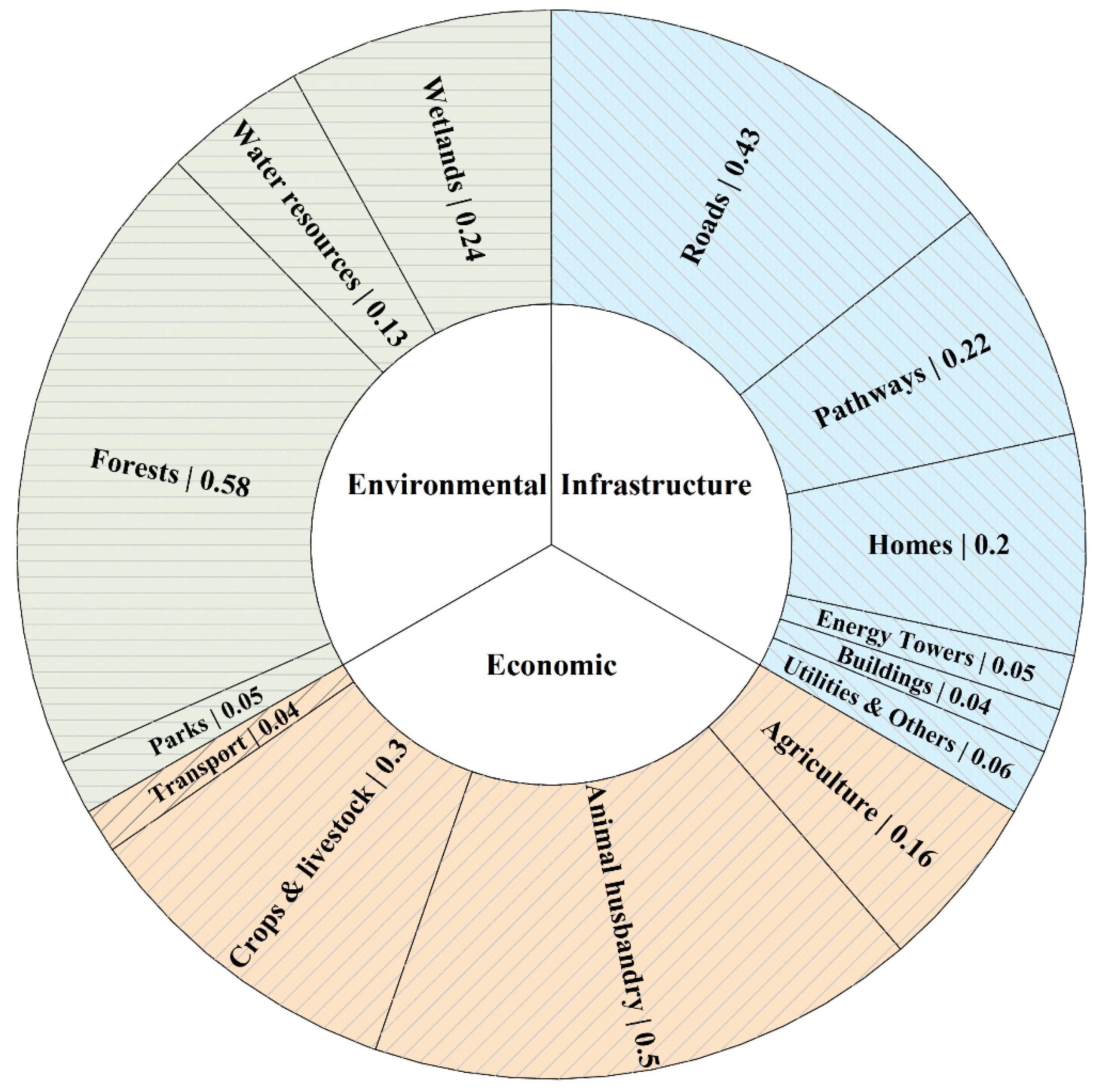
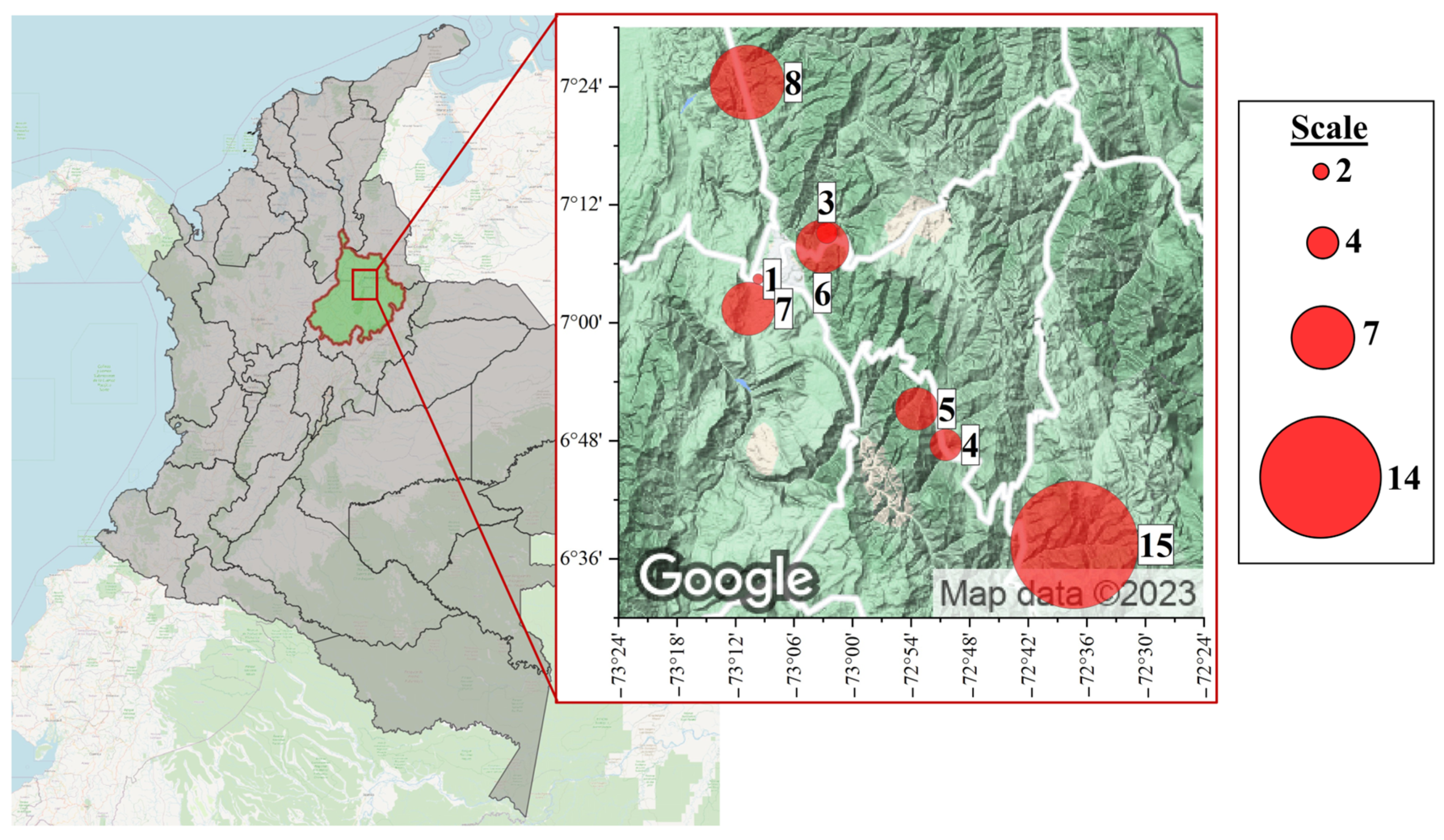

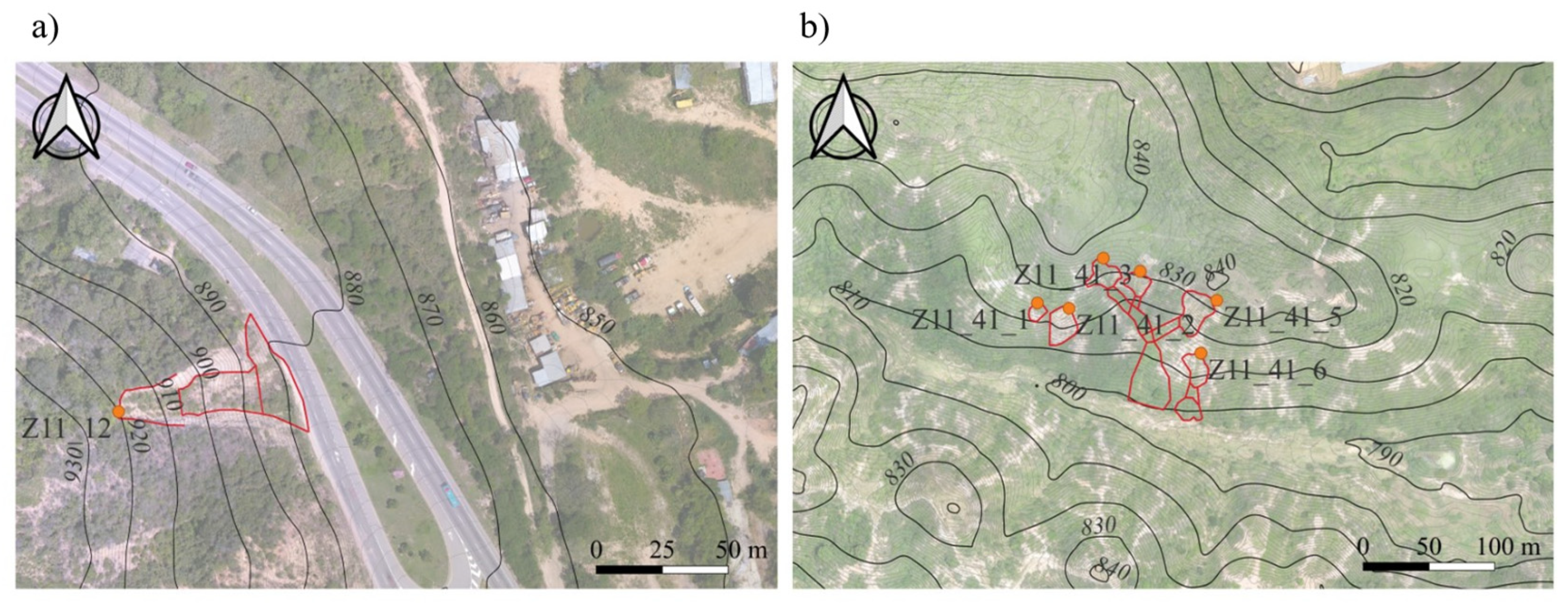
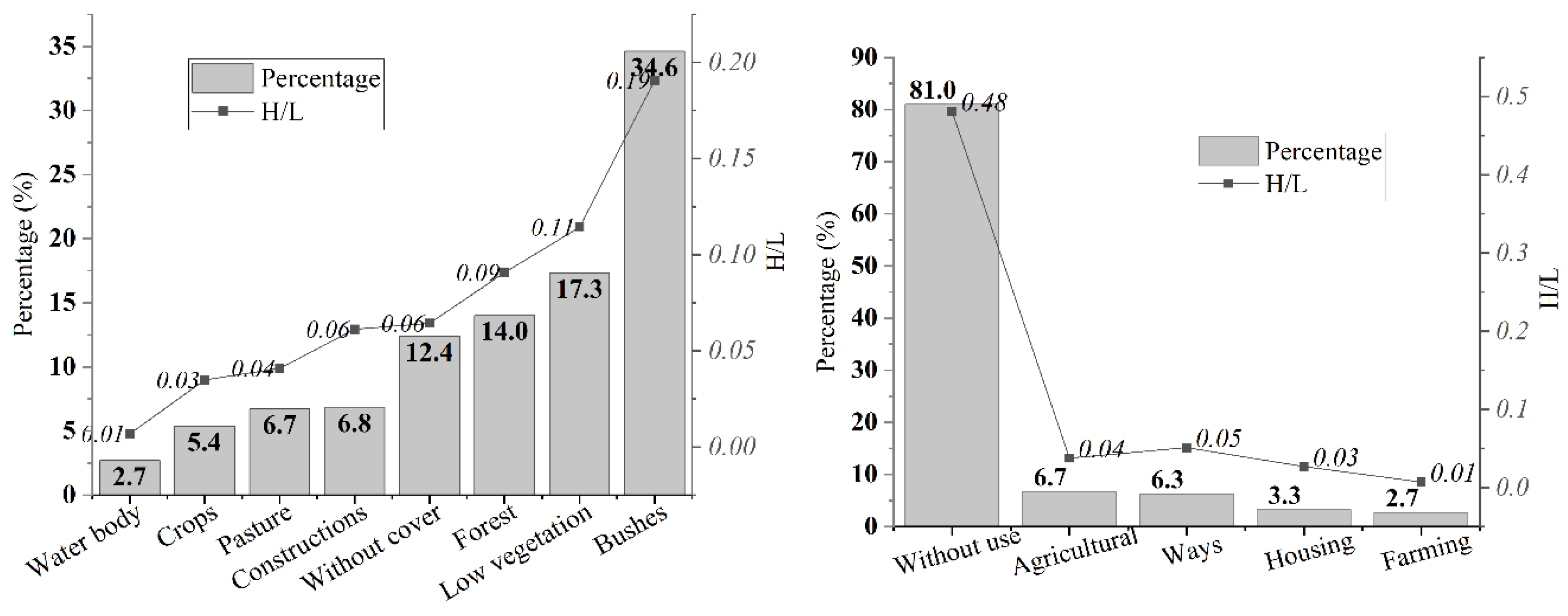
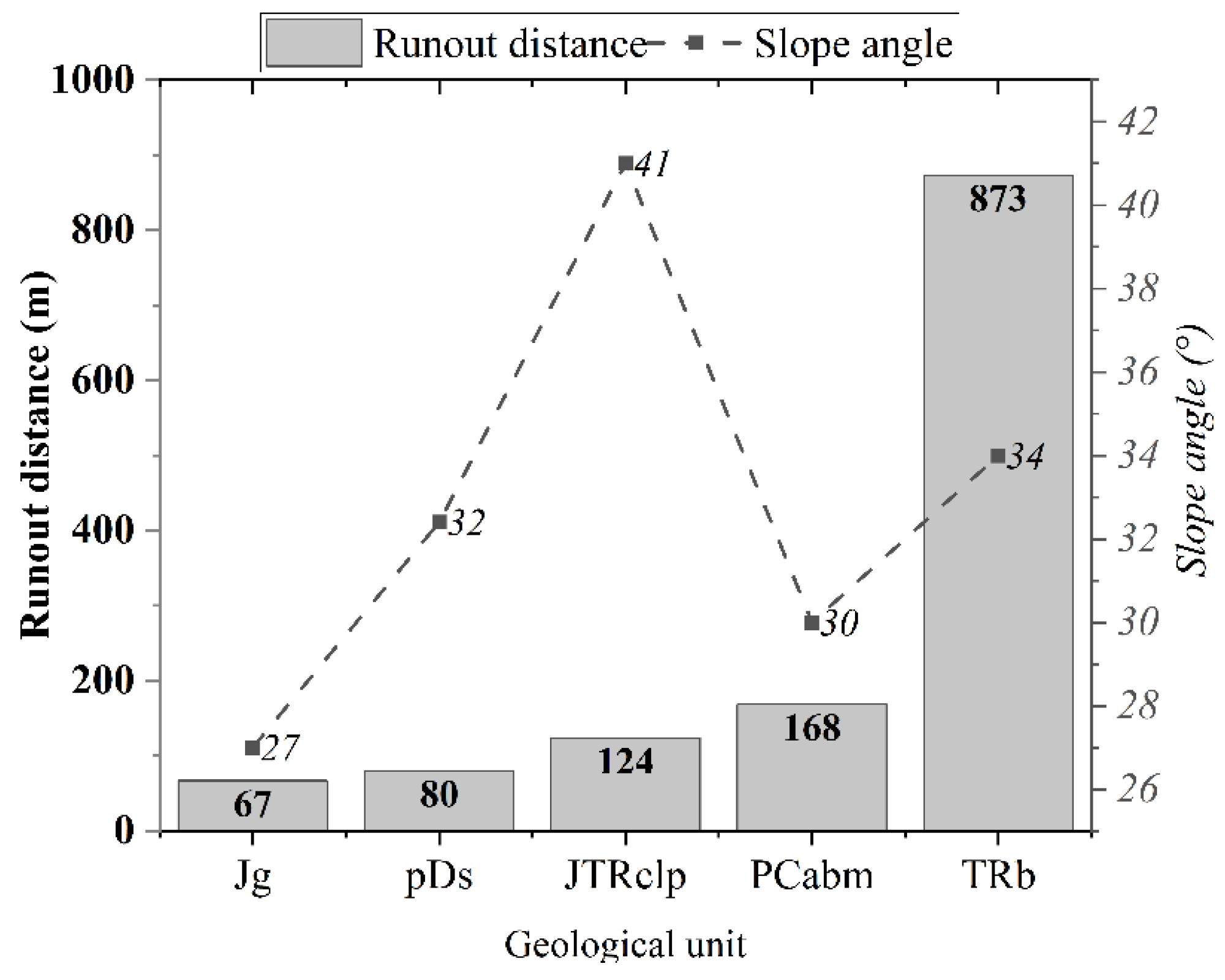

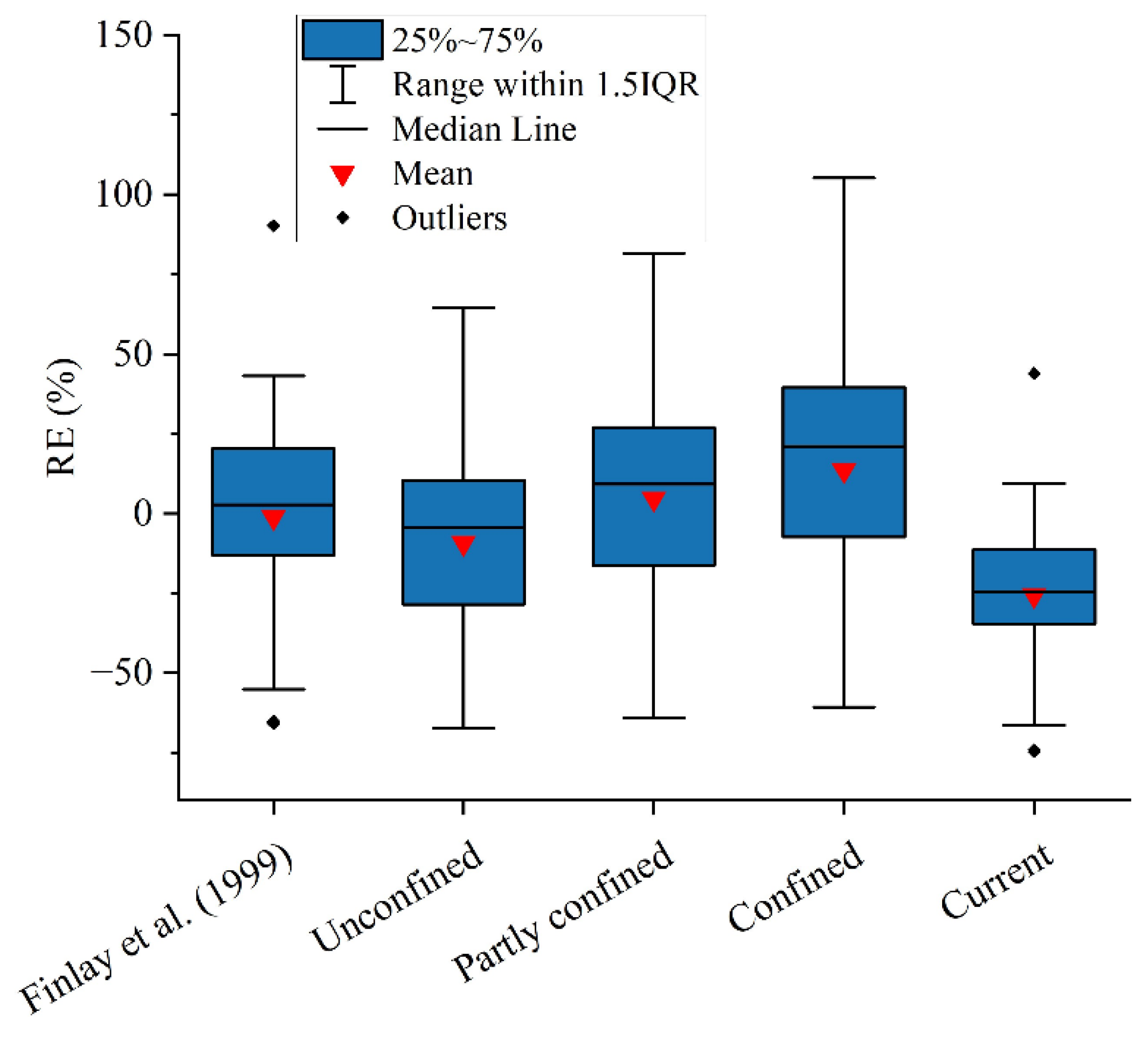
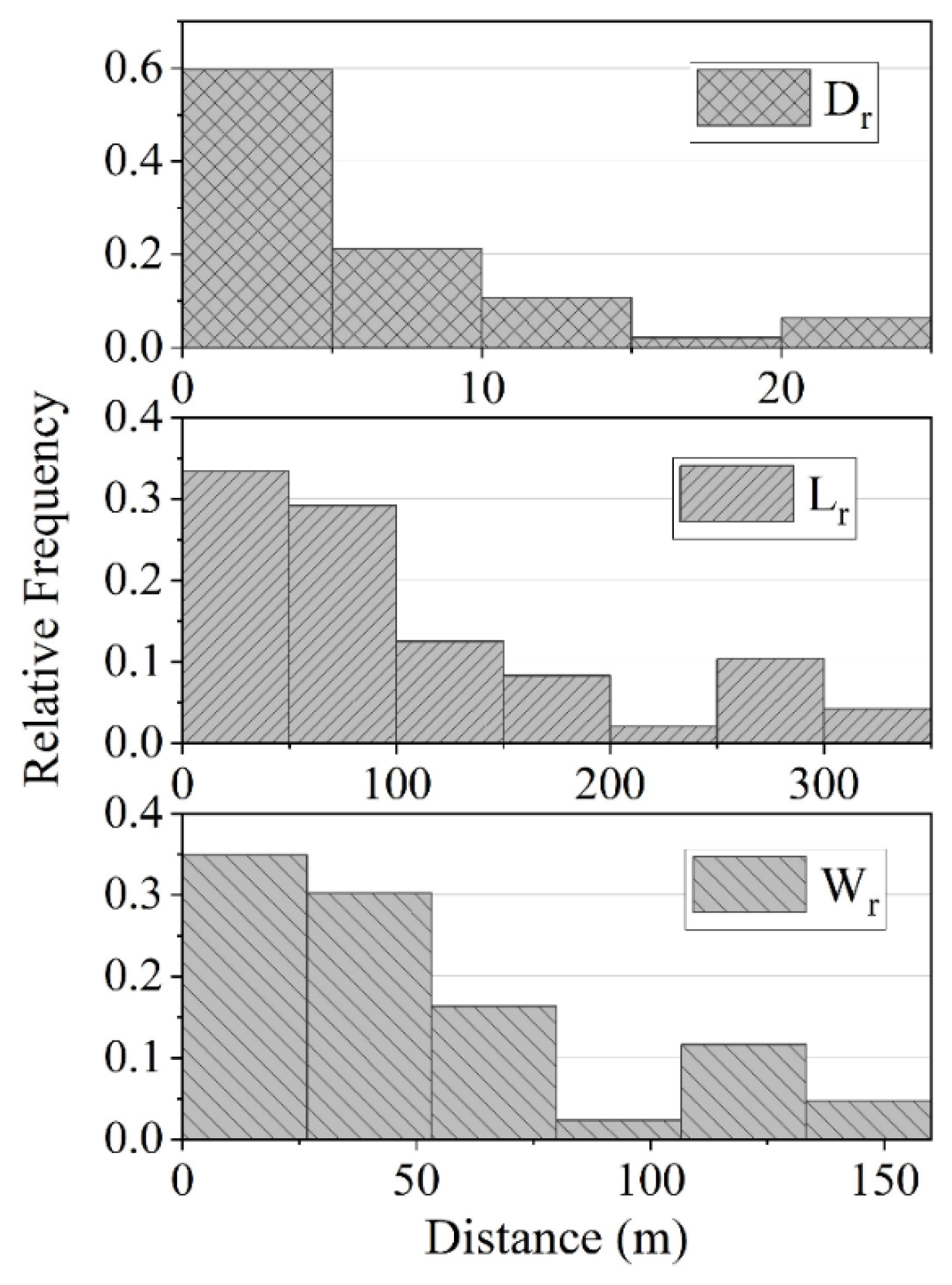

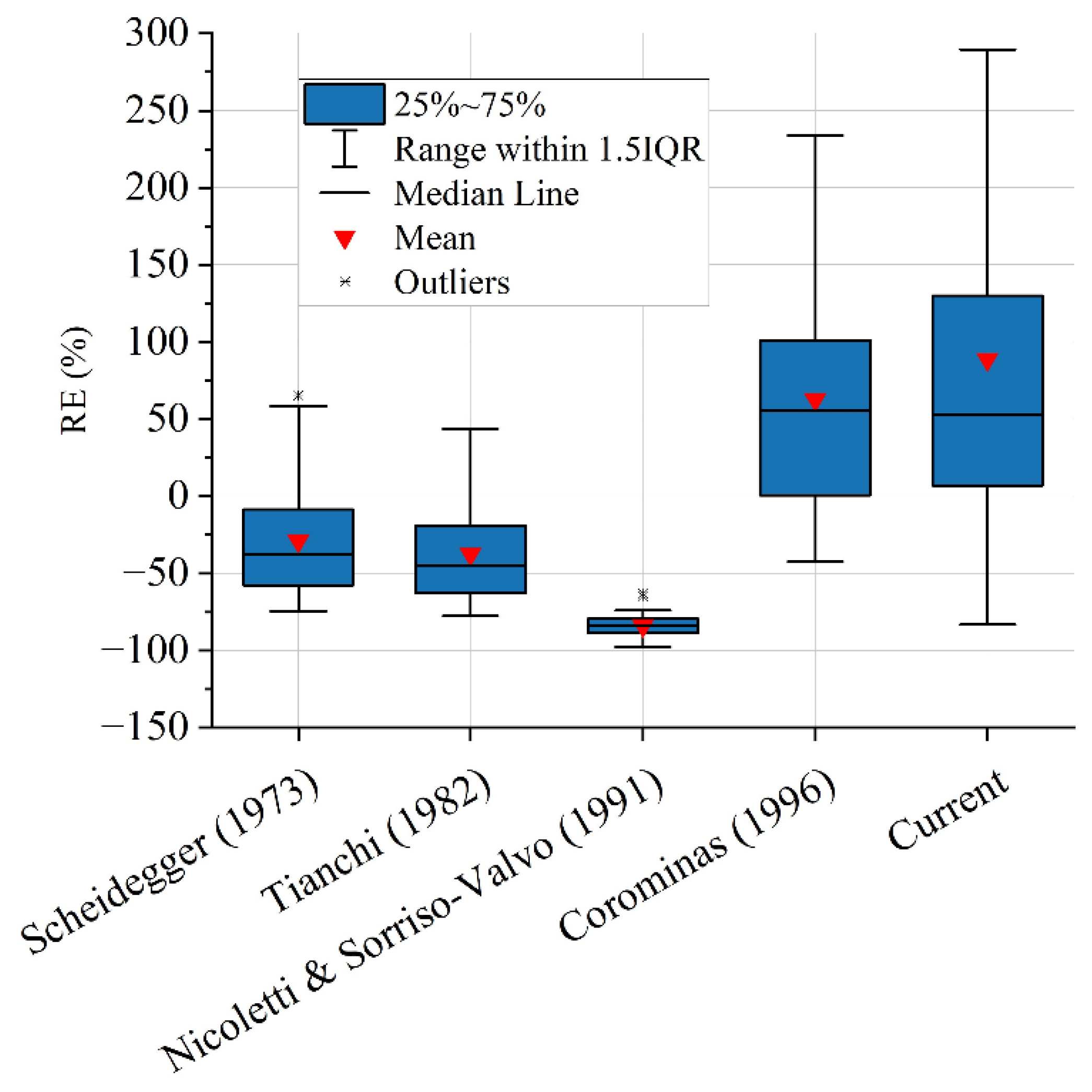

| Study | |||
|---|---|---|---|
| [15] | 0.624 | −0.157 | 0.67 |
| [16] | 0.664 | −0.153 | 0.61 |
| [17] | 0.527 | 0.085 | 0.14 |
| [18] | −0.047 | −0.085 | 0.63 |
| [29] | 0.087 | 0.770 | 0.71 |
| Acronym | Geological Formation | Description |
|---|---|---|
| Jg | Girón | Slightly weathered sandstones of the Girón formation |
| pDs | Silgará | Phyllite, schists and quartzites |
| JTRclp | La Corcova | La Corcova quartz monzonite with porphyritic facies |
| PCabm | Bucaramanga | Gneiss with abundant small masses of orthogneiss |
| TRb | Bocas | Gray to brownish gray sandstone and mudstone |
| Model | , * | ||
|---|---|---|---|
| From [30]: Cut slope | 0.109 | 1.010, −0.506 * | 0.85 |
| From [29]: Unconfined | 0.087 | 0.77 | 0.71 |
| From [29]: Partly confined | 0.086 | 0.69 | 0.52 |
| From [29]: Confined | 0.147 | 0.54 | 0.85 |
| Current study | 0.449 | 0.52 | 0.31 |
Disclaimer/Publisher’s Note: The statements, opinions and data contained in all publications are solely those of the individual author(s) and contributor(s) and not of MDPI and/or the editor(s). MDPI and/or the editor(s) disclaim responsibility for any injury to people or property resulting from any ideas, methods, instructions or products referred to in the content. |
© 2024 by the authors. Licensee MDPI, Basel, Switzerland. This article is an open access article distributed under the terms and conditions of the Creative Commons Attribution (CC BY) license (https://creativecommons.org/licenses/by/4.0/).
Share and Cite
Roman Quintero, D.C.; Ortiz Contreras, J.D.; Tapias Camacho, M.A.; Oviedo-Ocaña, E.R. Empirical Estimation of Landslide Runout Distance Using Geometrical Approximations in the Colombian North–East Andean Region. Sustainability 2024, 16, 793. https://doi.org/10.3390/su16020793
Roman Quintero DC, Ortiz Contreras JD, Tapias Camacho MA, Oviedo-Ocaña ER. Empirical Estimation of Landslide Runout Distance Using Geometrical Approximations in the Colombian North–East Andean Region. Sustainability. 2024; 16(2):793. https://doi.org/10.3390/su16020793
Chicago/Turabian StyleRoman Quintero, Daniel Camilo, Jose David Ortiz Contreras, Mauricio Alberto Tapias Camacho, and Edgar Ricardo Oviedo-Ocaña. 2024. "Empirical Estimation of Landslide Runout Distance Using Geometrical Approximations in the Colombian North–East Andean Region" Sustainability 16, no. 2: 793. https://doi.org/10.3390/su16020793
APA StyleRoman Quintero, D. C., Ortiz Contreras, J. D., Tapias Camacho, M. A., & Oviedo-Ocaña, E. R. (2024). Empirical Estimation of Landslide Runout Distance Using Geometrical Approximations in the Colombian North–East Andean Region. Sustainability, 16(2), 793. https://doi.org/10.3390/su16020793







